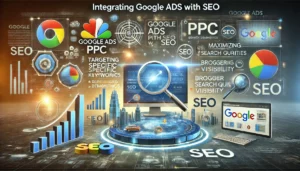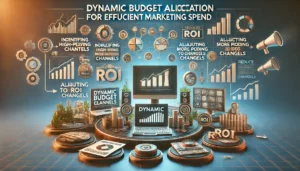Unlocking Marketing Synergy: The Untapped Potential of Blended CPA for Superior ROI

Potential of Blended CPA: In today’s fast-paced marketing world, using separate strategies for different channels can hold your business back. Many companies miss out on the benefits of a blended approach. Blended CPA (Cost Per Acquisition) offers a way to combine efforts across channels for better results. This article will explore the limitations of siloed marketing, explain the advantages of a blended CPA model, and show how integrating various strategies can boost your ROI.
Key Takeaways
- Siloed marketing efforts can lead to missed opportunities and inefficiencies.
- Blended CPA combines multiple channels for a more effective strategy.
- Integrating PPC and SEO can help target unreachable keywords and boost organic search.
- Email marketing enhances lead nurturing and conversion rates when used with other channels.
- Unified data insights help optimize budget allocation and maximise ROI.
The Limitations of Siloed Marketing Efforts
Missed Opportunities for Synergy
When marketing teams operate in silos, they often miss out on the chance to create a unified strategy. This lack of coordination can lead to missed opportunities for synergy between different channels. For example, a well-timed email campaign could support a social media blitz, but only if the teams are working together.
Conflicting Messages Across Channels
Siloed efforts can result in conflicting messages being sent to your audience. One team might be pushing a discount, while another is promoting a premium service. This inconsistency can confuse customers and dilute your brand’s message. It’s crucial to maintain a consistent voice across all marketing channels.
Inefficiencies in Resource Allocation
Without a unified approach, resource allocation becomes inefficient. You might end up spending too much on one channel while neglecting another that could offer better returns. A coordinated strategy helps in identifying the most effective channels and ensures optimal use of your marketing budget.
Inefficiencies in resource allocation can lead to wasted budget and missed opportunities for higher ROI. A unified strategy is essential for maximizing the impact of your marketing efforts.
Understanding the Blended CPA Model
Defining Blended CPA
Blended CPA, or Cost Per Acquisition, is a metric that combines the costs of various marketing channels to determine the overall cost to acquire a customer. Unlike traditional CPA, which focuses on a single channel, blended CPA provides a more comprehensive view of your marketing spend. This holistic approach allows you to see the bigger picture and make more informed decisions.
Benefits Over Traditional CPA
One of the key advantages of blended CPA is its ability to highlight inefficiencies across different channels. By understanding where your money is going, you can allocate resources more effectively. This model also helps in identifying the channels that are performing well and those that need improvement. Additionally, the potential of blended CPA can lead to better budget management and higher ROI.
Real-World Examples of Success
Many companies have successfully implemented blended CPA strategies to boost their marketing performance. For instance, a retail brand might use a combination of PPC, SEO, and social media ads to drive sales. By analysing the blended CPA, they can determine which channels are most cost-effective and adjust their strategies accordingly. This approach not only saves money but also maximises the impact of their marketing efforts.
Blended CPA offers a unified view of your marketing spend, enabling smarter decisions and better results.
Integrating PPC and SEO for Enhanced Performance
Targeting Unreachable Keywords
Integrating Google ads PPC with SEO can help you target specific keywords or demographics that are not immediately reachable through organic search. This combination allows you to cover a broader range of search queries, ensuring that your brand appears in front of a wider audience. By leveraging both strategies, you can maximise your visibility and capture potential customers at different stages of their buying journey.
Boosting Organic Search with Paid Ads
Using Google Adwords PPC can significantly boost your organic search efforts. When your paid ads appear alongside your organic listings, it increases your brand’s credibility and visibility. This dual approach can lead to higher click-through rates and improved overall performance. A PPC agency or a London PPC agency can help you optimise this strategy for better results.
Case Studies of Successful Integration
Several Google ads agencies have successfully integrated PPC and SEO to achieve remarkable results. For instance, a PPC management firm collaborated with an eCommerce ppc client to run a Google ads audit and a PPC audit. The outcome was a 30% increase in organic traffic and a 25% boost in conversion rates. This case study highlights the potential benefits of a well-coordinated strategy between PPC ad agency efforts and SEO initiatives.
Integrating PPC and SEO is not just about running ads and optimising content separately. It’s about creating a cohesive strategy that leverages the strengths of both approaches to drive superior results. Google advertising agencies and PPC eCommerce agency experts can guide you through this process, ensuring that your campaigns are aligned and effective.
Leveraging Email Marketing for Lead Nurturing
Enhancing Conversion Rates
Email marketing is a powerful tool for directly reaching consumers with tailored content. By sending newsletters, promotional offers, and product updates, brands can keep subscribers informed and interested. Personalised email campaigns, driven by customer data and preferences, enhance engagement and conversion rates. Automated email sequences can nurture leads, onboard new customers, and re-engage inactive subscribers.
Cross-Channel Synergy
The synergy between email marketing workflows and sales processes is equally crucial. Integrating these workflows facilitates a seamless transition for leads from initial engagement to eventual conversion. Automated coordination between marketing and sales teams ensures that the right messages are delivered at the right stages, optimising the chances of turning leads into loyal customers.
Personalisation Strategies
Segmented campaigns help you build meaningful and ongoing relationships with customers. You can anticipate their needs by interpreting habits and behavioural data. As a result, you can offer subgroups the right incentives and benefits to make further purchases. Once you’ve crafted your lead magnet, it’s time to create an irresistible opt-in offer that encourages your audience to take action. This opt-in offer takes them from social media followers to real leads, often by getting them to join your email list. By running contests, initiating interesting conversations, and interacting with followers in meaningful ways, you can create a sense of community that goes beyond transactional relationships. For example, you could try giving away small prizes via email.
- Targeted, insight-driven messaging that shows you understand the prospect’s problems
- Personalised email sequences with helpful content. Consultative follow-ups that demonstrate persistence and expertise
- Multi-channel coordination across digital and offline touchpoints
The goal is to initiate two-way conversations and build relationships with future buyers. Cold outreach powers that crucial top-of-funnel motion that ultimately drives sales and revenue.
Optimising Budget Allocation with Unified Data Insights
Identifying High-Performing Channels
Start by integrating data from various sources like advertising platforms and CRM systems. This unified data management allows you to analyse cross-channel interactions and identify patterns. With this information, you can pinpoint which channels are performing best and deserve more investment.
Adjusting Budgets Based on Performance
Once you have identified high-performing channels, the next step is to adjust your budgets accordingly. Allocate more funds to channels that show higher ROI and reduce spending on underperforming ones. This dynamic budget allocation ensures that your marketing dollars are spent efficiently.
Maximising ROI Through Strategic Investment
To maximise ROI, use the insights gained from your unified data to make strategic investments. This means not just shifting budgets but also optimising campaigns for better performance. Regularly analyse and optimise your strategies to ensure you are getting the most out of your investments.
By leveraging unified data insights, you can make informed decisions that lead to better budget allocation and higher ROI. This approach not only saves money but also enhances the overall effectiveness of your marketing strategy.
Collaborative Strategy Development Between Teams
Aligning Marketing and Sales Goals
To achieve superior results, it’s crucial to align the goals of your marketing and sales teams. When both teams work towards a common objective, they can create more cohesive and effective campaigns. Collaboration ensures that marketing efforts are directly contributing to revenue generation. This alignment can be fostered through regular meetings, shared KPIs, and integrated planning sessions.
Creating Unified Campaigns
Unified campaigns are the result of seamless collaboration between teams. By pooling resources and expertise, you can design campaigns that leverage the strengths of both marketing and sales. This approach not only enhances the overall effectiveness of your campaigns but also ensures a consistent message across all channels. Consider using collaborative tools and platforms to streamline communication and project management.
Improving Lead Quality and Revenue Generation
When marketing and sales teams collaborate effectively, the quality of leads improves significantly. Marketing can provide sales with valuable insights into customer behaviour and preferences, while sales can offer feedback on lead quality and conversion rates. This exchange of information helps in refining strategies and targeting high-quality leads, ultimately boosting revenue. Effective collaboration leads to a more efficient sales funnel and higher ROI.
Regular collaboration between marketing and sales teams is essential for creating strategies that drive revenue and improve lead quality. By working together, these teams can achieve greater success than they would individually.
The Potential of Blended CPA: The Role of AI
Artificial Intelligence (AI) is revolutionising the way marketers approach blended Cost Per Acquisition (CPA) strategies. By leveraging AI, you can enhance user acquisition, boost revenue metrics, and achieve real-time conversion tracking. This section explores how AI can be a game-changer in your marketing efforts.
Enhancing User Acquisition
AI can significantly improve your user acquisition strategies. By analysing vast amounts of data, AI algorithms can identify patterns and trends that human analysts might miss. This allows you to target the right audience more effectively, leading to higher conversion rates. AI-driven insights can help you optimise your campaigns in real-time, ensuring you get the most out of your marketing budget.
Boosting Revenue Metrics
When it comes to boosting revenue metrics, AI offers unparalleled advantages. It can predict customer behaviour, allowing you to tailor your marketing efforts to meet their needs. This not only increases sales but also improves customer satisfaction. AI can also automate various aspects of your marketing campaigns, freeing up your team to focus on more strategic tasks.
Real-Time Conversion Tracking
Real-time conversion tracking is another area where AI excels. Traditional methods of tracking conversions can be slow and often inaccurate. AI, on the other hand, provides real-time data, allowing you to make immediate adjustments to your campaigns. This ensures that you are always on top of your marketing performance, enabling you to make data-driven decisions quickly.
Leveraging AI in your blended CPA strategies can lead to more efficient and effective marketing campaigns, ultimately driving superior ROI.
In summary, integrating AI into your blended CPA strategies can provide you with the tools you need to stay ahead of the competition. From enhancing user acquisition to boosting revenue metrics and real-time conversion tracking, AI offers a comprehensive solution for modern marketers.
The Potential of Blended CPA in Conclusion
In conclusion, blending CPA strategies can unlock new levels of marketing success. By integrating different marketing channels and aligning them towards a common goal, businesses can achieve superior ROI. This approach not only enhances efficiency but also ensures that marketing efforts are cohesive and more impactful. As digital marketing continues to evolve, the potential of blended CPA model could be the key to staying ahead of the competition and maximising returns. Embrace this strategy to see your marketing efforts thrive in today’s dynamic landscape.
Frequently Asked Questions
What is Blended CPA?
Blended CPA (Cost Per Acquisition) combines costs from multiple marketing channels to give an overall cost for acquiring a customer. This approach helps in understanding the total expense involved in gaining a new customer across all channels.
Why are siloed marketing efforts less effective?
Siloed marketing efforts often lead to missed opportunities for synergy, conflicting messages across channels, and inefficient use of resources. By working separately, teams can’t leverage the full potential of their combined efforts.
How does integrating PPC and SEO improve performance?
Integrating PPC (Pay-Per-Click) and SEO (Search Engine Optimisation) helps target keywords that are hard to rank for organically. PPC ads can boost organic search results, making the overall strategy more effective.
Potential of Blended CPA: What are the benefits of using Blended CPA over traditional CPA?
Blended CPA provides a more comprehensive view of marketing costs by combining expenses from different channels. This helps in better budget allocation, improved synergy between channels, and ultimately, a higher return on investment (ROI).
How can email marketing enhance lead nurturing?
Email marketing helps in nurturing leads by providing personalised content and timely follow-ups. This increases conversion rates and creates a synergy with other marketing channels, making the overall strategy more effective.
What role does AI play in Blended CPA strategies?
AI helps in real-time conversion tracking, enhancing user acquisition, and boosting revenue metrics. It provides valuable insights that can optimise marketing strategies and improve overall performance.
Author
Search Blog
Free PPC Audit
Subscribe to our Newsletter
The Voices of Our Success: Your Words, Our Pride
Don't just take our word for it. With over 100+ five-star reviews, we let our work-and our satisfied clients-speak for us.
"We have been working with PPC Geeks for around 6 months and have found Mark and the team to be very impressive. Having worked with a few companies in this and similar sectors, I rate PPC Geeks as the strongest I have come across. They have taken time to understand our business, our market and competitors and supported us to devise a strategy to generate business. I value the expertise Mark and his team provide and trust them to make the best recommendations for the long-term."
~ Just Go, Alasdair Anderson




